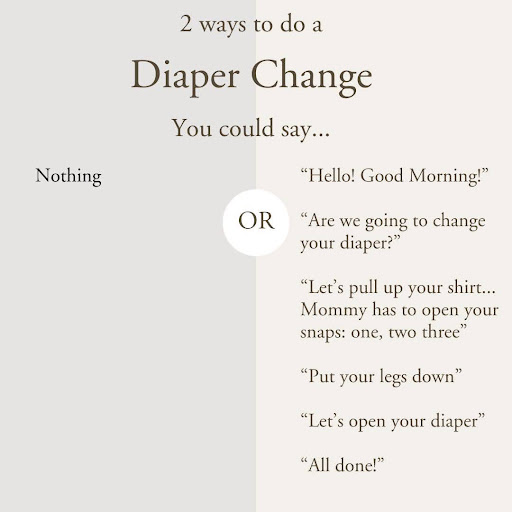How can you actually talk to a baby? When do you start? How do you even talk to a baby?
As a speech pathologist and mom of three, I’ve heard all these questions! The short answer is a resounding YES! The best time to start? In the womb! Babies actually begin to distinguish voices while still tucked inside their mama’s belly. This leaves the most complicated part of the question: How?
How do we talk to a baby?
The good news is babies’ brains are hard-wired to learn language. They are designed to listen, process, and piece apart words and sounds to decipher the language (or languages!) they are exposed to. What these little sponges do need, is input. They need exposure to language, and lots of it. They also need it presented in a meaningful, engaged manner. Just listening to a show on TV doesn’t cut it (research proves it!)

The top 5 things you can do to pave the way for talking to a baby
So what can we do to help present language in a way that will help our little ones pick it up, understand it, and eventually produce it? Here are 5 tips parents can utilize in their day to day lives:

1. Infant-Directed Speech (aka Motherese or Parentese)
What is parentese, or motherese? Parentese refers to that rich elongation and prolongation of sounds you hear people often use when they talk to babies. It’s essentially infant-directed speech. We all just thought we were doing it because it was cute, but it turns out there is research to support its use. The intense fluctuations in intonation along with pauses, and prolonged sounds help not only to keep babies’ attention, but also helps babies to pick up the beginnings and ends of words so they can distinguish individual words in a long string of speech.

2. Take Turns
Start saying something to your baby such as, “Good morning! Are you awake?” then wait for a response… and respond back! To anything and everything! Anytime baby uses their little voice- a coo and babble, a squeal- respond to that verbalization with a response, “Oh really? I didn’t know that… are you hungry?”
In the early days, it isn’t as important the content of what you are saying, as it is that you are teaching them that their vocalizations carry meaning (and power!), which in turn encourages them to vocalize more.

3. Imitate
As your baby starts to develop a variety of sounds and noises, they will begin to play with their voice to see just what it can do. Repeat back what baby says to you! Showcase their sounds, and teach them to imitate. By imitating them, they will (eventually) learn to imitate the sounds and words that you say. Those may just turn into their first little words!

4. Narrate
Conversation with a baby may be a little one-sided, but you can always use your voice to describe what you are doing while you are going about your day. This will give baby access to rich language chock full of crucial vocabulary, as well as the building blocks for simple phrases and sentences. Baby will hear how words are put together, and eventually begin picking up on patterns in your speech (thing, -ing endings for actions/verbs, basic pronouns I/you).

5. Use correct grammar
It’s great to talk with increased intonation, just be sure to use correct grammar and sounds. Babies learn by listening, and if we are saying things incorrectly consistently, it can make it more difficult for them to put those building blocks of language together.

A great way to implement some of these is right on the changing table!
Instead of quietly changing your babies diaper, try saying some of the following:
“Hello! Good Morning!”
“Are we going to change your diaper?”
“Let’s pull up your shirt… Mommy has to open your snaps: one, two three”
“Put your legs down” “Let’s open your diaper”
“All done!”

If you are a first time parent, it may feel unnatural to talk to a baby like this!
But the more infant directed speech you can use, the more you talk to them, and the more you narrate what is going on around them, the more they can understand your speech. If you ever have questions, don’t hesitate to reach out to a speech pathologist –- we are here to help!
On more support through different stages and milestones of your babies life, read The Mama Coach: Personalized Support Through Each Stage of Parenthood




0 Comments